TrueTube 1/14/19: Flowing Lava edition
This week's guide to digital nonfiction video: Skunk Bear RIP, Burnout, Shane Dawson etc
January 14, 2018
By Eli Kintisch
In focus: Pour one out for Skunk Bear
Adam Cole is among the most talented and underappreciated science video makers working today. For four years he’s produced incredibly inventive pieces as head of Skunk Bear, NPR’s quirky science-video-and-tumblr-and-audio vertical. News came before the holidays that Skunk Bear is ending as Cole joins Vox’s Explained on a six month contract, after which he’ll be looking for a job. (He’d hope to return at some point to NPR, Cole tells me.)
So…time for a brief paen to Cole and the fantastic worlds he’s conjured for Skunk Bear, which will now live in perpetuity on YouTube’s servers.

Cole says publically that he first landed his job at NPR with this adorable video about fecal waste:
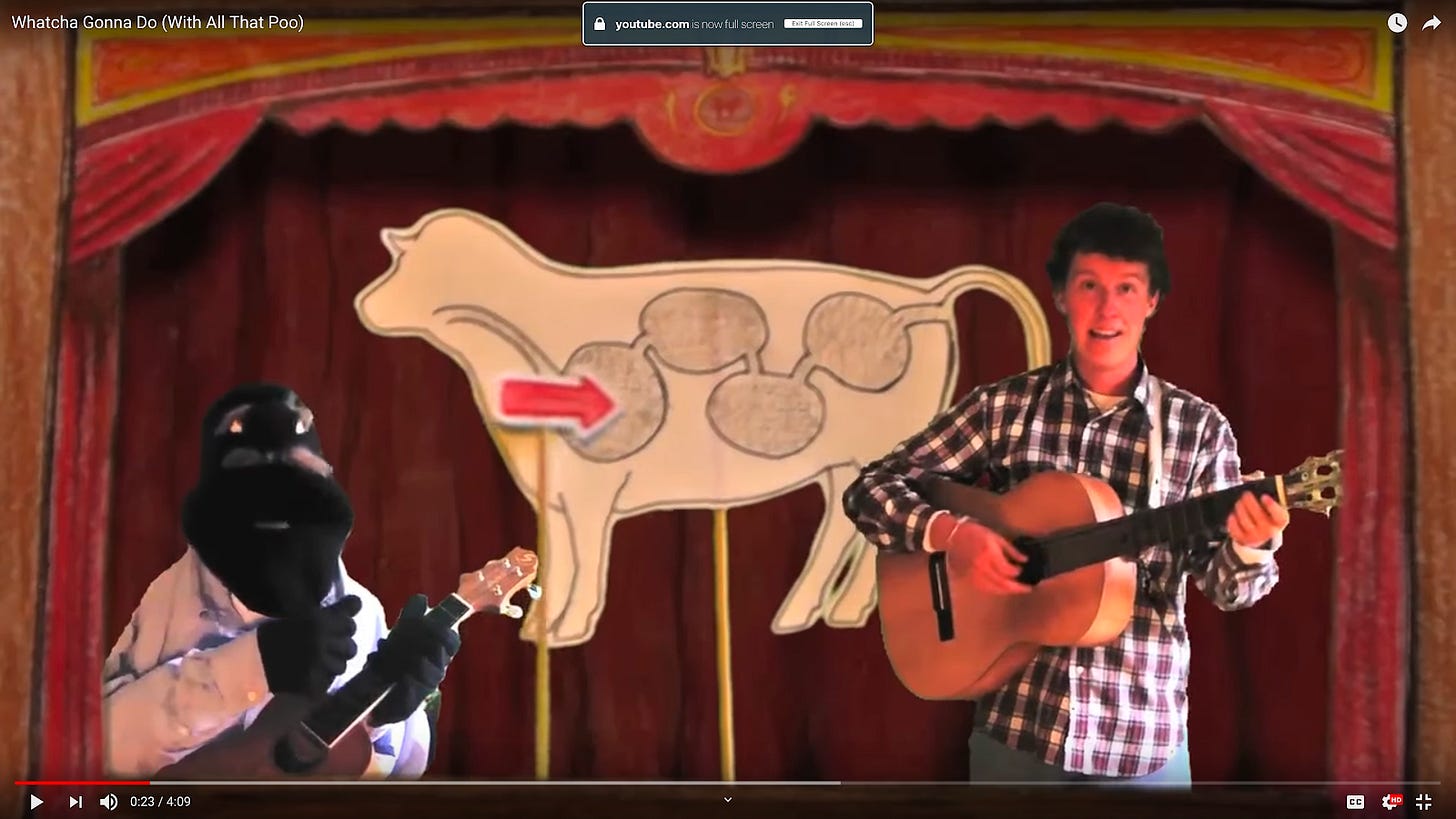
Later, Skunk Bear was conceived as a “sandbox of sorts where I could experiment with different storytelling techniques and develop my own voice.” It didn’t take long for that voice to emerge. His first video with the brand, in 2014, showcased his impressive skills: a masterful animation of a science story about plants that regenerate. Its textured, relatable images were accompanied by a pitch-perfect sound design and script that was as delightful as it was informative. A cult following emerged as he published more videos: a moving, silly tribute to an ancient tortoise, a calculation of the speed of light with Peeps (including one playing Galileo) and this melodic, sincere review of “dumb-sounding” birds.
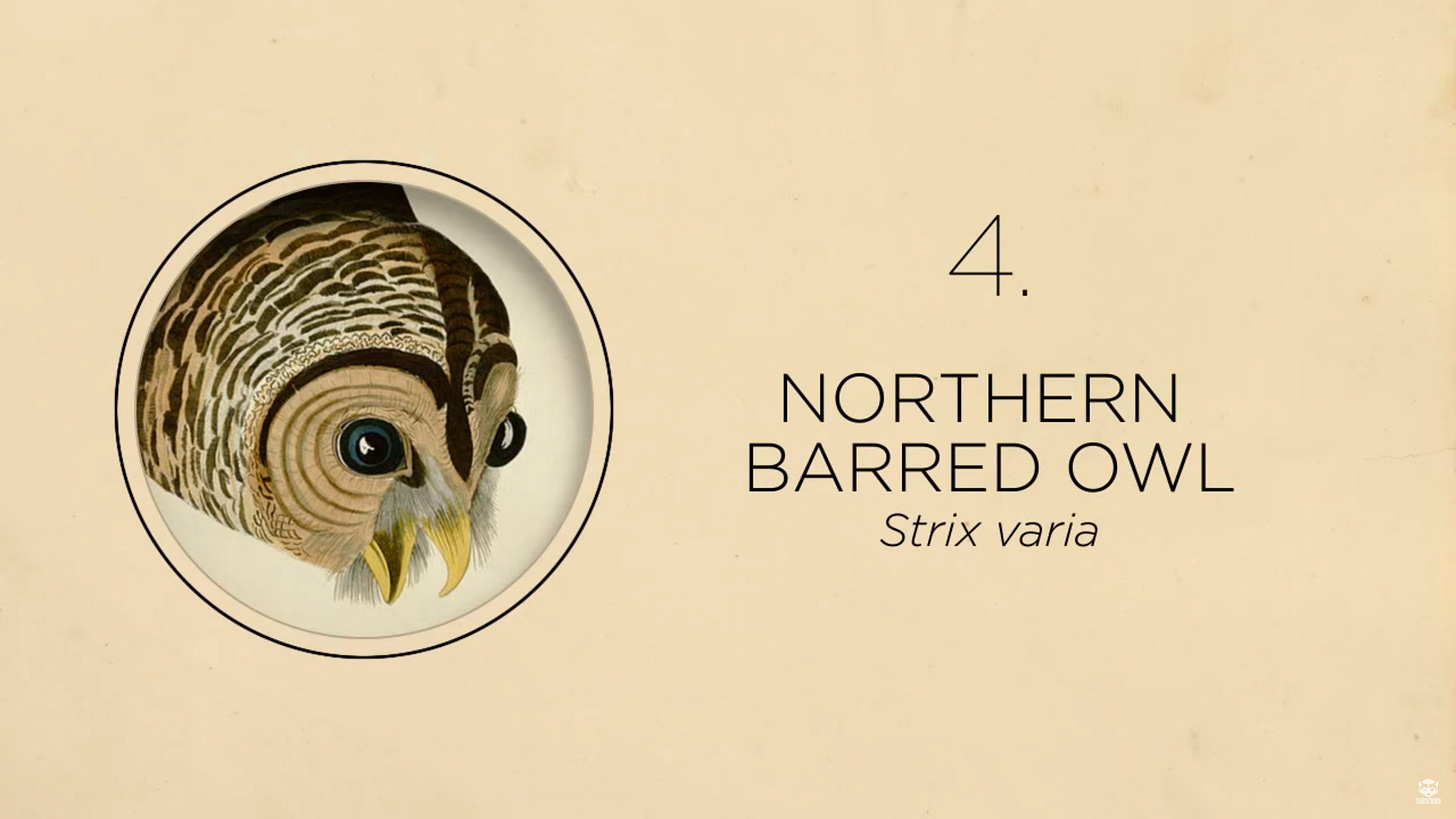
How did Cole become the five-tool Ken Griffey Jr. of science video? Long hours in that sandbox, apparently. “If you want to grow, stay half an hour after work and try something you have no idea how to do,” he said here. As he gained skills, he applied his drawing, animation, music and writing chops to create increasingly ambitious and engrossing videos. In Your Body’s Real Age, check out here how the camera moves as the 3D animation develops. To unravel a mystery involving a skeleton, Cole mixed narration on camera, b-roll, animation, banjo picking and voice-over into a rich audiovisual stew. His trademark: seamlessly combining real-life footage and props with animation and text, like when he literally held a mirror to the viewer’s brain or ingeniously charted earth’s history with plastic animals and light rope on the Morgan State football field. A video about lava could have shown the predictable science-fair volcano toy by using quick cutaway to b-roll. Instead, Cole lowered a simmering model into the frame on a string.
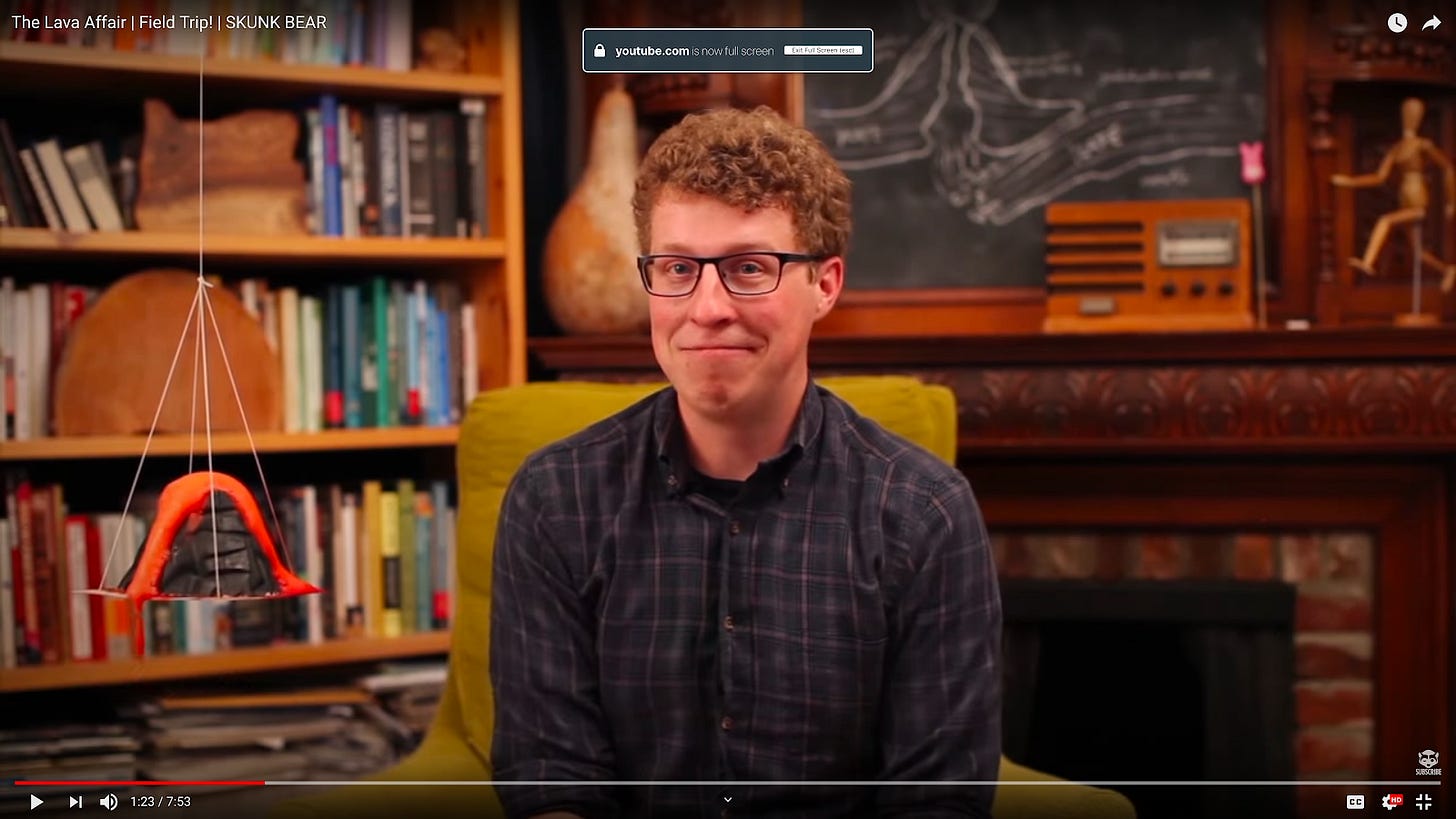
But did that level of complex production doom Skunk Bear on YouTube? Adam’s tiny team -- co-producer Ryan Kellman, senior editor Allison Richards and a few others at NPR deserve credit too -- couldn’t publish their meticulously constructed pieces frequently enough to gain traction. Over the 50 months of the channel’s life, they published 51 videos, or about one per month.
Compare that output with, say, RealLifeLore, a good explainer channel that over 33 months of its existence has published 123 videos -- about one per week. This video describing an (insane) plan to hydrate the Sahara, for example, tells a compelling story with stock photos and relatively simple graphics, and has earned 860k views. More published videos mean more chances to steadily gain subscribers, win advertisers, and convince the algorithm to feature your videos. RealLifeLore deserves the two million subscribers it’s earned.
Skunk Bear’s videos are richer, with original art, sound and footage. And yet few earned more than 200,000 views. As of early 2019 the channel had garnered only 87k subscribers. That’s respectable, but disappointing given the care and creativity that went into each piece. “Lovely video, wondering why you have so little subscribers,” wrote a typically appreciative commenter in 2016. “There are some questions even skunk bear can't answer,” responded another commenter.
In an email Cole tells me one reason for the slow growth:
Doing lots of experimenting meant we didn't commit to one style or form, and so I wasn't making a clear promise or selling a clear product to the audience. Why would they subscribe to come back if they didn't know what they were getting? But the much bigger consistency problem was the infrequency and irregularity of posting - again a product of experimentation. We didn't know how long each production would take and couldn't iterate to become more efficient. Because we never committed to a clear set of conventions for each episode, we tended to follow our creativity down some very time-intensive side roads.
Big success on Facebook suggested that more consistency would have helped:
We started a Facebook show page in August of 2017, supplementing new episodes with archival episodes previously published on YouTube. As a result, we were able to publish at least twice a month, sometimes more. Thanks in part to the frequency of publishing, we gained 1 million followers in our first year, and averaged 2.6 million 30-second-views per video
Skunk Bear’s end underscores the challenge of sustaining quality, highly produced streaming video. With the formidable resources of Netflix and Vox behind him, and a bigger audience watching, it will be exciting to see what Cole makes next. One thing’s for certain: NPR’s loss is Vox’s gain.
Disclosure: I’ve worked with both Vox and NPR as a freelance and consider Cole a professional colleague.
Industry News
Could old videos help battle creator burnout? Making online videos is an exhausting job that exhausts the army of low-paid creators that do it. Could YouTube be promoting older videos as an effort to fight the problem? Lately YouTube seems to be suggesting more so-called “library” videos -- think, more than a week old -- in the coveted viewers’ Recommended tab. Analyst Matt Gelen of Tubefilter theorizes that these older videos might be cropping up more because the burnout crisis has persuaded YouTube to nurture its creators and reduce the incentives to upload, upload, upload...
Where you need to be to get noticed? Reddit’s r/videos, where careers are made and fortunes won.
Want 3.2 million subscribers fast? As Jack Black recently learned, it helps to be an (ubertalented) celebrity…
Loooong videos. Last year YouTube stalwart Shane Dawson basically invented a new format, the multi-part docuseries, that dominated YouTube, with three long video series profiling other successful YouTubers. Videos on Jake Paul (8 videos, ~7 hours), Jeffree Star (5 videos, ~3 hours total) Tana Mongeau (3 videos, ~1.5 hours total) racked up a whopping 306 million views. So it’s understandable that there’s a new focus on long videos on the platform. The algorithm rewards long watch times, which is one of the reasons gaming channels have performed so well for years.
Other nonfiction creators are getting into the act. Lindsay Ellis, for example, makes thoughtful essays about movies, books and entertainment. They regularly garner more than 700k views...and run more than 20 minutes. (On this podcast she explains how she does it, including a paid staff of writers and editors that allow her to publish so much content.) So in 2019 individual creators on YouTube may be making longer and longer videos.
A shot I liked
Given its skewering-the-millennials pose, it’s not surprising that the deliciously dark Netflix fictional show You spends a lot of time on the screens of its characters cellphones. But it does so particularly creatively:
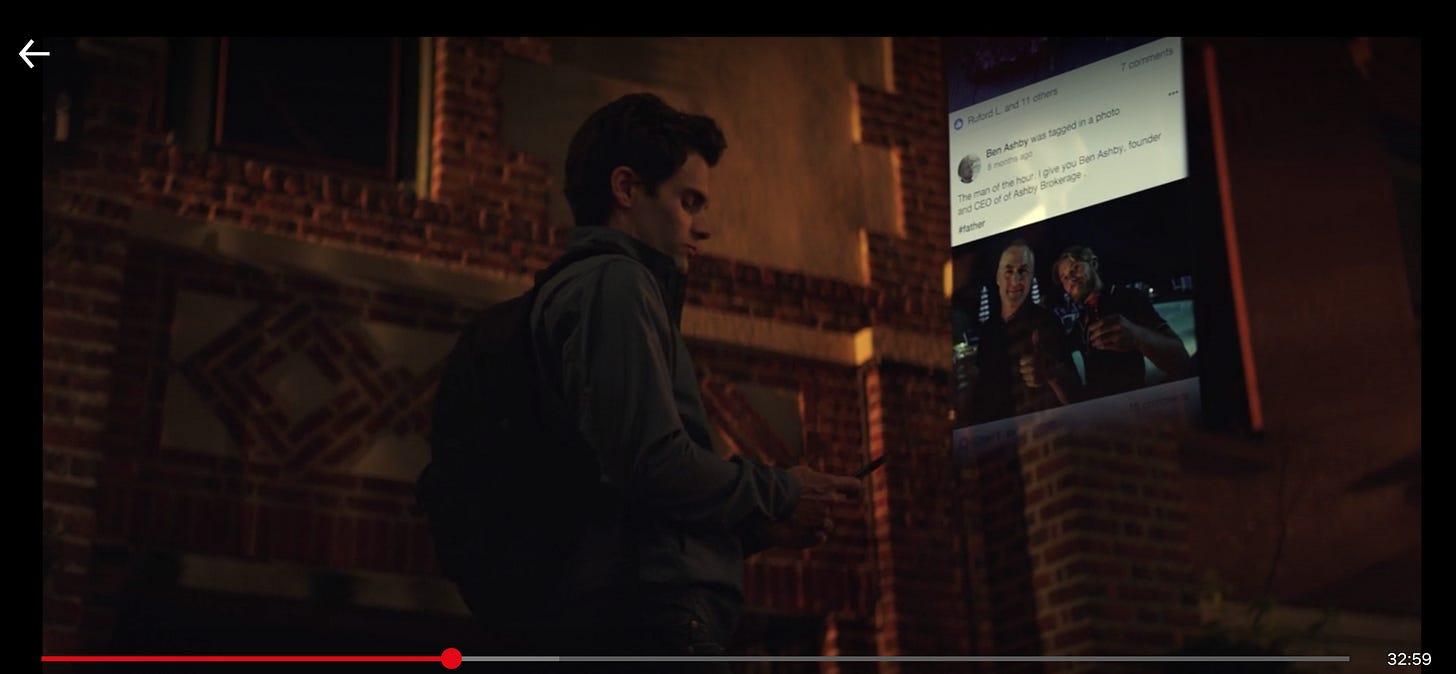
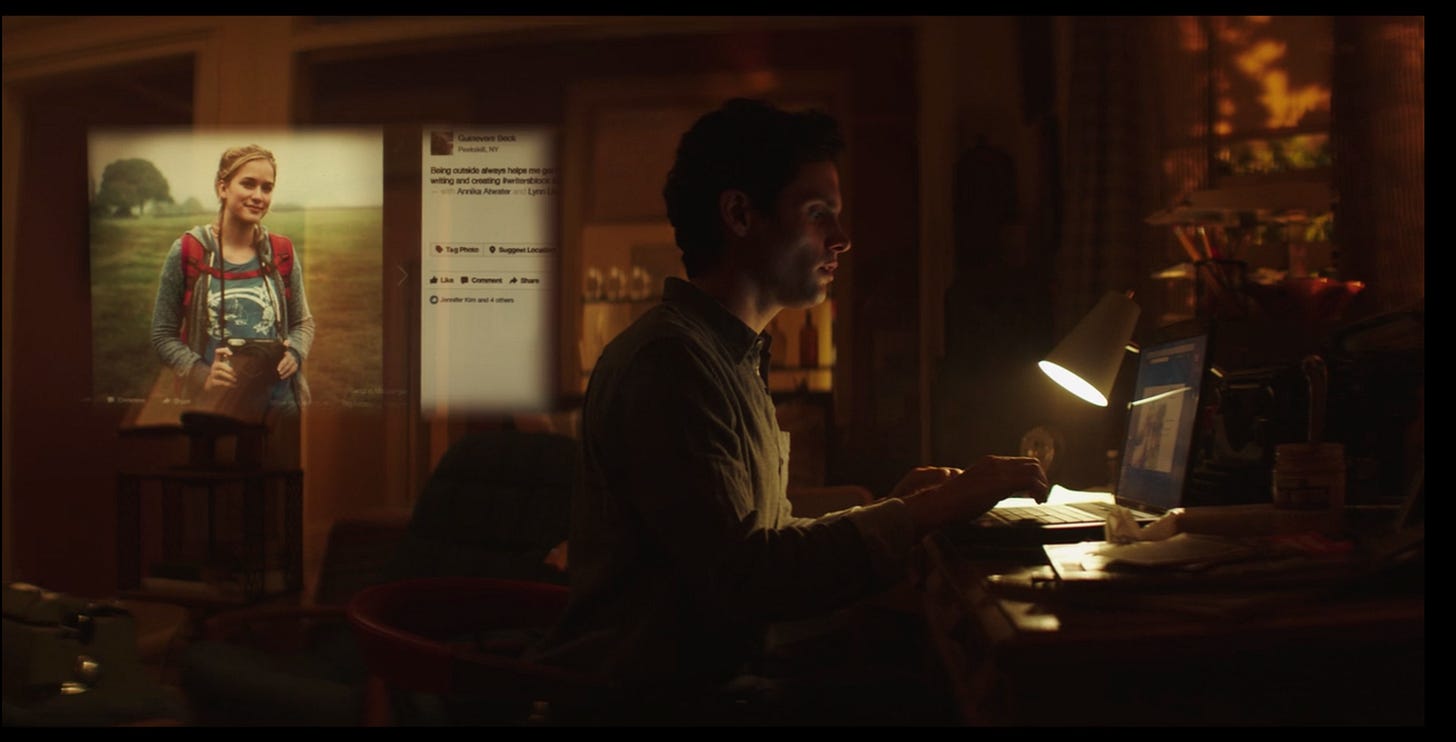
More on how we visualize social media on screen: how Crazy Rich Asians wildly tracked a rumor’s digital spread with animation; how blockbuster movies actually avoid depicting smartphones doing what we mostly use them for: social media, web browsing, and texting.
Doc of the week
Crisanto Street, published last month by the Guardian, is the bittersweet story of eight-year-old Geovany Cesario, who lives in a trailer near Silicon Valley and must soon move. (Paloma Martinez, dir., 11 min.)

Explainers of the week
Seventeen history-focused YouTube channels have made 17 different videos covering seafaring from Chinese explorers to the introduction of ironclad ships.
Will Chilton has started ASTRO, a YouTube channel, with explainer How to Move More Cars, Faster (Hint: Congestion Pricing).
Recent faves
Musician/video wizard Andrew Huang discovers that Mars wind is playing an e minor chord.
A remarkable three-part digital documentary by the NYT on the Soviet disinformation campaign that claimed that the U.S. government had created AIDS. (Thanks reader E for the tip.)
Questions of the week
Animated science channel Kurzgesagt, with nearly 8 million subscribers, is a nerdy powerhouse. Why does YouTube’s algorithm put atop the channel’s “Related Channels” list (mine at least!) the channel of gamer/provocateur/user-of-racist-words PewDiePie?
YouTube handily offers keyboard shortcuts j/k/l that move videos back and forth, just like in video editing software. Could Vimeo please adopt these? When you press L in Vimeo it just indicates that I just liked a video (Which to be fair, I usually do…)
Tools
You’re probably subscribed to YouTube channels whose videos you don’t see when you access the site on a phone or laptop. If you want more control over what video options you can see, use an RSS reader like Inoreader (my favorite) or Feedly (probably the most useful one). Here’s how...
Thanks for reading! Subscribe!
-- Eli
Want to share a video or tip for the newsletter? Email me at elikint@gmail.com
TrueTube is a weekly roundup of the best in streaming nonfiction video, including minidocs, explainers and educational channels. Inspired by Hot Pod, informed by my own tastes!
About me: I’m a video producer, science journalist, carpentry enthusiast. Website Twitter Instagram

